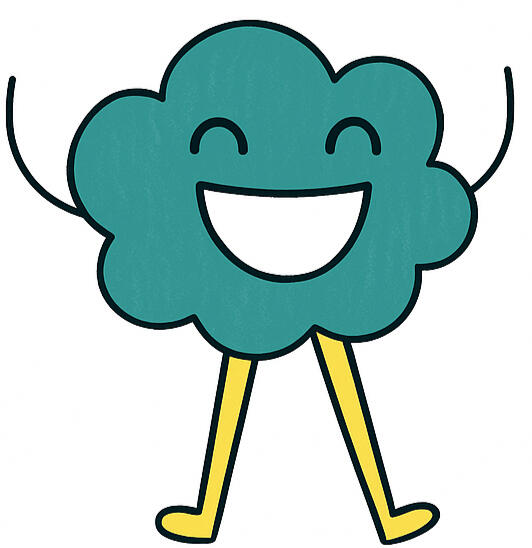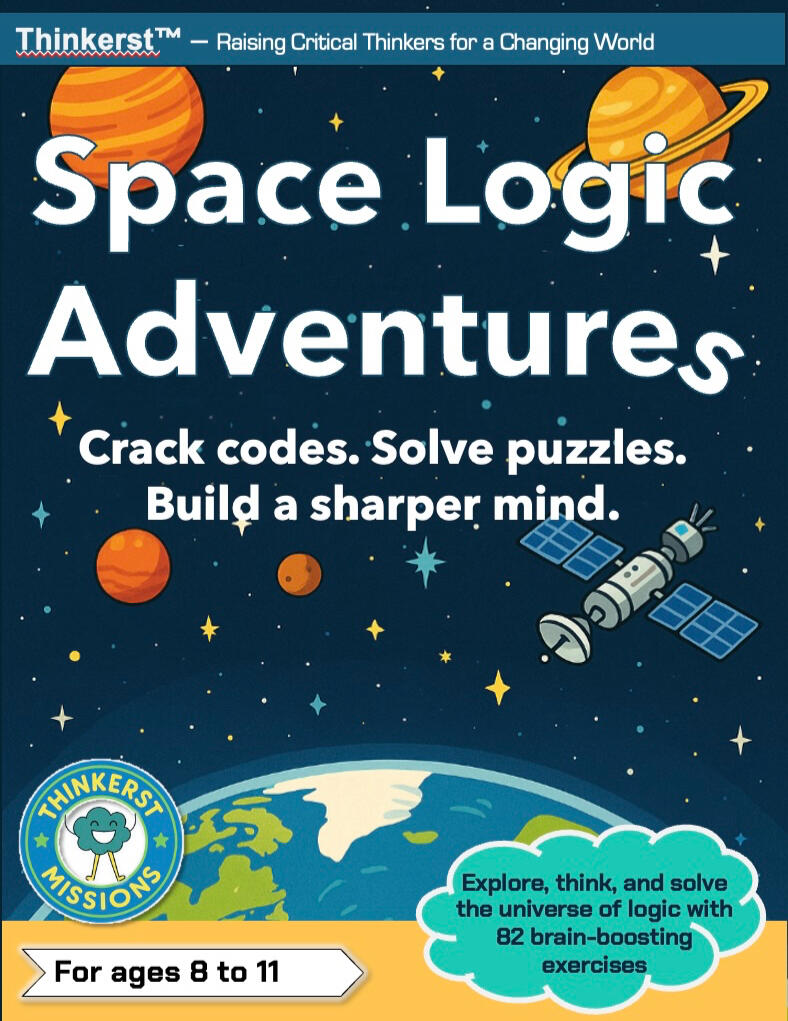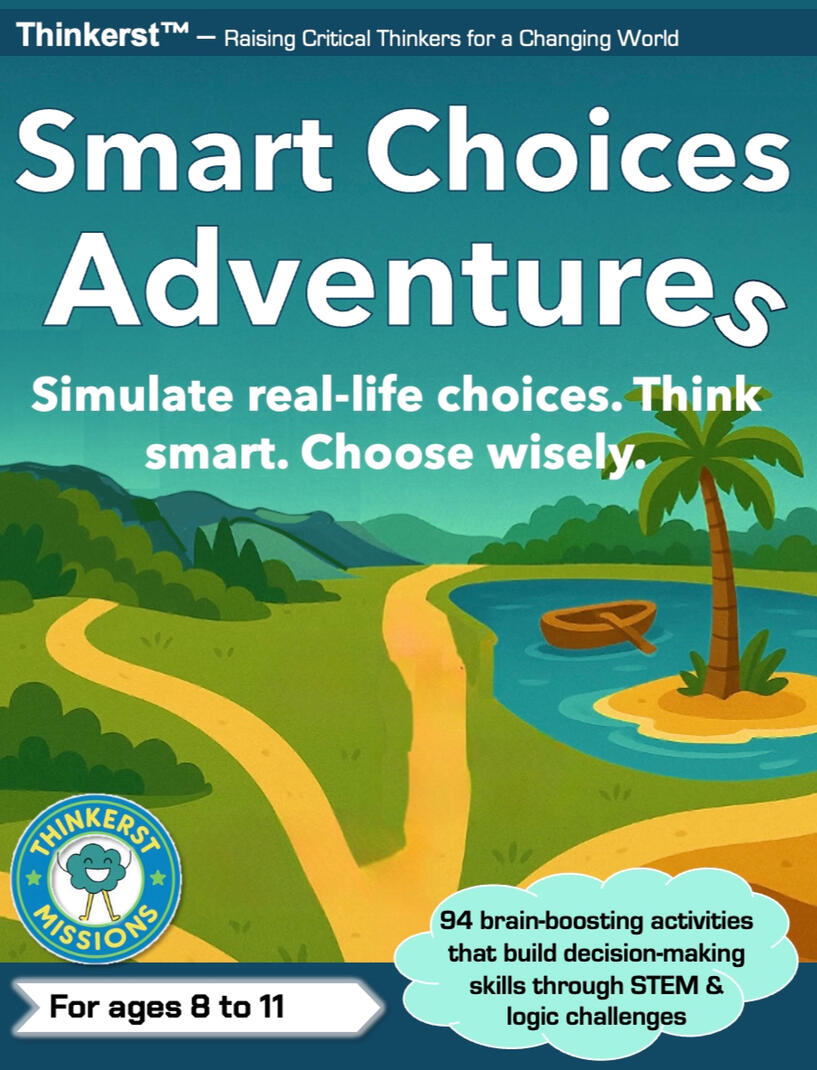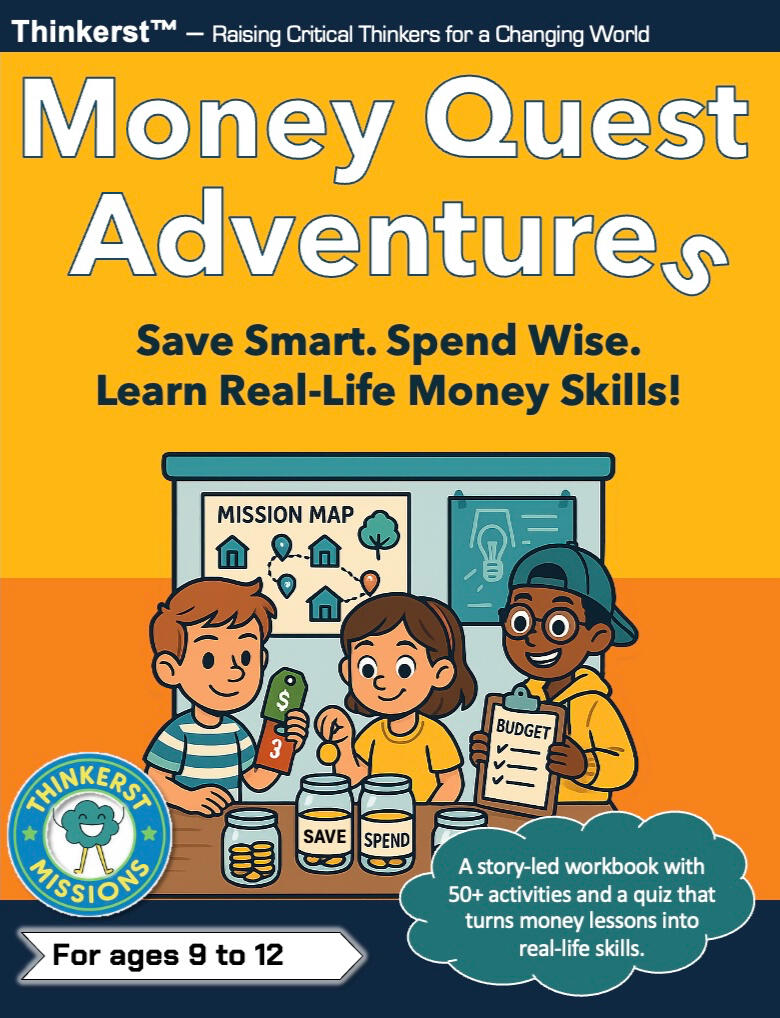
Thinkerst™
where kids learn to think!
Why Thinkerst™?
We live in an age of information overload, yet many young minds are left unchallenged. Instead of learning to think critically, kids are passively consuming content.Thinkerst™ was created to change that by equipping elementary school students with real thinking tools for a fast-changing world shaped by AI and innovation.Our programs use story-based simulations to immerse kids in real-life decision-making. For example, in Smart Choices Adventures, students navigate everyday dilemmas, weighing short- vs. long-term consequences. In Money Quest Adventures, they learn financial literacy by running an eco-business and making smart money choices.Every challenge blends logic, math, reading, and ethical thinking into one meaningful journey.Through these workbooks and live enrichment classes, kids build:
1. Logic & spatial reasoning
2. Reading comprehension & decision-making
3. Systems thinking & math
4. Executive function & focusUsed in schools and homes alike, Thinkerst workbooks also stand alone as powerful resources for gifted and curious learners who thrive at their own pace. They're perfect for kids who enjoy solving meaningful problems and stretching their thinking independently.We currently partner with Sharon, MA schools to bring this vision to life in grades 3–5. And as we grow, our on-demand classes will expand access to even more families.Beyond academics, Thinkerst also promotes healthier screen habits, because strong minds need space to grow.
About The Author
Hi! I’m Milly. My journey has taken me from classrooms to corporations across Europe and the U.S., with a career spanning elementary and higher education, finance, data analytics, and corporate strategy. Whether teaching, leading teams, or working with executives, one theme has always guided me: think clearly, connect the dots, ask the right questions at the right time, and move forward with purpose.But everything shifted when my own child started school.Despite rapid innovation and the efforts of many dedicated teachers, I saw how slow the education system is to adapt. My curious, imaginative child became disengaged, and I realized: kids don’t just need facts. They need tools to think critically, solve problems, and adapt creatively.At the same time, I began to see how easily screens can take hold of young minds, including my own child’s. Like so many parents, I felt the growing tension between meaningful learning and passive digital consumption.That insight led to Thinkerst™.Leaving behind the corporate world, I returned to education with a fresh lens. I created Thinkerst Adventures, a series of workbooks that help kids build executive function and cognitive skills through logic, storytelling, and creative thinking. It’s the first of many tools I’m developing to prepare kids not just for school, but for life.To thrive in today’s world, kids need to learn how to think by spotting patterns, linking ideas, and making thoughtful decisions. And in a world of endless digital distractions, that kind of thinking isn’t just helpful, it’s essential.

Products
1. Space Logic Adventures - designed for kids 8 to 11 years old, this engaging, space-themed workbook develops logical and holistic thinking through fun, and real-world challenges. Kids will learn to link information, recognize patterns, and approach problems with a big-picture mindset - key skills for future problem-solvers.

2. Smart Choices Adventures - fun decision-making workbook for kids ages 8–11 that combines real-life thinking skills, STEM challenges, logic puzzles, and eco-friendly activities in one engaging story-based adventure. Most kids’ workbooks are packed with random puzzles that feel disconnected from real life. Smart Choices Adventures is different, it places every challenge in a real-world context where kids’ decisions truly matter.

3. Money Quest Adventures – a fun, story-led money workbook for kids ages 9–12 that simulates real-life money decisions through eco-business adventures, smart budgeting missions, and ethical challenges. Unlike typical workbooks that just teach coins and counting, Money Quest Adventures puts kids in charge of running a planet-friendly business, making real-world choices about saving, spending, giving, and growing their impact. Through this interactive simulation, kids learn practical financial skills while building confidence, creativity, and a sense of purpose.

Q&A
1. What makes Thinkerst™ workbooks different? Here's what to expect: 1) engaging storyline with cartoon characters and illustrations (think of it as a fusion of critical thinking puzzles and the visual storytelling of a graphic novel), 2) diverse exercises covering multiple skills, and 3) an opportunity for kids to discover what they’re naturally good at—whether it’s logic, strategy, creativity, spatial reasoning, or decision-making.2. Who is Thinkerst™ content for? Thinkerst™ content is designed for elementary school kids who can read. It fosters independent, self-paced learning, with occasional guidance from a parent/guardian or teacher.3. Can Thinkerst™ workbooks be used both at home and in classroom? Yes, absolutely. They are designed for learning at home or in the classroom with a teacher, to spark the thinking process and encourage conversation. These workbooks work well in group settings, where kids can collaborate in small teams.4. How should parents or teachers use Thinkerst™ content with their child/students? Encourage kids to think independently, knowing that some exercises will be easy and others more challenging—both are part of the learning process. Every challenge helps us grow! Feel free to check the answers at the back of the workbook when needed. Lastly, keep track of a healthy amount of concentration time for your kids or students, ensuring they don’t overwork themselves.5. Can I get a sample of the workbook? Yes! A selection of exercises is included in the free sample. Go to the products section and click "Free Sample Download". Answers are not included in the sample but are available in the full workbook.6. Is there a digital version of the workbook available for purchase? At Thinkerst™, we believe kids thrive with less screen time and more hands-on learning. That’s why our main workbooks are available only as physical, paperback editions. Writing by hand strengthens memory, focus, and critical thinking in ways digital formats can’t fully replicate.
For teachers and parents who prefer print-at-home resources, we also offer selected chapters as downloadable printables on Teachers Pay Teachers. These are still designed for offline use—encouraging kids to read, write, and engage without extra screen time.7. Is Thinkerst™ aligned with officially recognized cognitive skill frameworks in the U.S.? Yes! Thinkerst aligns with multiple officially recognized cognitive skill frameworks to ensure a well-rounded learning experience. Our workbooks incorporate elements from Bloom’s Taxonomy, the CHC Theory of Intelligence, the Delphi report on Critical Thinking, the 21st Century Skills Framework, and research of Executive Functions and Multiple Intelligences. By integrating these models, we cover a wide range of essential cognitive skills, including critical thinking, problem-solving, decision-making, reasoning, and creativity.For any questions related to Thinkerst™ and its products, feel free to reach out through the contact section.
Our mission
At Thinkerst, we’re on a mission to raise a generation of creative, resilient thinkers. We do this by:
1. Creating story-led workbooks that build creative and critical thinking through problem-solving adventures, empowering kids to become adaptable and confident in an ever-changing world.2. Bringing learning to life with interactive logic and decision-making classes in elementary schools and libraries, helping kids practice teamwork, focus, and real-world thinking.3. Advocating for mindful screen time, encouraging purposeful, creative use of technology instead of passive scrolling and gaming.
Live Classes
Thinkerst Live Enrichment Classes – Now in Sharon, MA Elementary Schools!
Thinkerst is proud to bring our Critical Thinking Through Logic program to Sharon elementary schools as part of their enrichment offerings. This 10-class semester program is inspired by our Space Logic Adventure workbook, where puzzles meet planets and thinking turns into a game.Students dive into creative challenges that build:
1. Spatial reasoning (like rotating objects in space or solving 3D mazes)
2. Informal logic (identifying patterns, making deductions)
3. Mathematical logic (using symbols and rules to solve structured problems)Designed to sharpen problem-solving skills and boost mental flexibility, our classes are hands-on, story-led, and confidence-building, perfect for curious minds in grades 2–5.📍 Now enrolling in Sharon, MA schools!
📅 One class per week for 10 weeks each semester (max 8 students per class to allow enough time for discussions, explorations, and thinking)
📚 All materials provided, just bring your brain!To learn more or bring Thinkerst to your school, reach out to: [email protected]